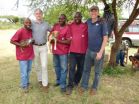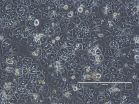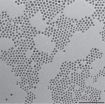(Press-News.org) The analysis of artifacts from a 325,000-year-old site in Armenia shows that human technological innovation occurred intermittently throughout the Old World, rather than spreading from a single point of origin, as previously thought.
The study, published today in the journal Science, examines thousands of stone artifacts retrieved from Nor Geghi 1, a unique site preserved between two lava flows dated to 200,000–400,000 years ago. Layers of floodplain sediments and an ancient soil found between these lava flows contain the archaeological material. The dating of volcanic ash found within the sediments and detailed study of the sediments themselves allowed researchers to correlate the stone tools with a period between 325,000 and 335,000 years ago when the Earth's climate was similar to today's.
The stone tools provide early evidence for the simultaneous use of two distinct technologies: biface technology, commonly associated with hand axe production during the Lower Paleolithic, and Levallois technology, a stone tool production method typically attributed to the Middle Stone Age in Africa and the Middle Paleolithic in Eurasia. Traditionally, Archaeologists use the development of Levallois technology and the disappearance of biface technology to mark the transition from the Lower to the Middle Paleolithic roughly 300,000 years ago.
Archaeologists have argued that Levallois technology was invented in Africa and spread to Eurasia with expanding human populations, replacing local biface technologies in the process. This theory draws a link between populations and technologies and thus equates technological change with demographic change. The co-existence of the two technologies at Nor Geghi 1 provides the first clear evidence that local populations developed Levallois technology out of existing biface technology.
"The combination of these different technologies in one place suggests to us that, about 325,000 years ago, people at the site were innovative," says Daniel Adler, associate professor of Anthropology at the University of Connecticut, and the study's lead author. Moreover, the chemical analysis of several hundred obsidian artifacts shows that humans at the site utilized obsidian outcrops from as far away as 120 kilometers (approximately 75 miles), suggesting they must also have been capable of exploiting large, environmentally diverse territories.
The paper argues that biface and Levallois technology, while distinct in many regards, share a common pedigree. In biface technology, a mass of stone is shaped through the removal of flakes from two surfaces in order to produce a tool such as a hand axe. The flakes detached during the manufacture of a biface are treated as waste. In Levallois technology, a mass of stone is shaped through the removal of flakes in order to produce a convex surface from which flakes of predetermined size and shape are detached. The predetermined flakes produced through Levallois technology are the desired products. Archaeologists suggest that Levallois t echnology is optimal in terms of raw material use and that the predetermined flakes are relatively small and easy to carry. These were important issues for the highly mobile hunter-gatherers of the time.
It is the novel combination of the shaping and flaking systems that distinguishes Levallois from other technologies, and highlights its evolutionary relationship to biface technology. Based on comparisons of archaeological data from sites in Africa, the Middle East, and Europe, the study also demonstrates that this evolution was gradual and intermittent, and that it occurred independently within different human populations who shared a common technological ancestry, says Adler. In other words Levallois technology evolved out of pre-existing biface technology in different places at different times.
This conclusion challenges the view held by some Archaeologists that technological change resulted from population change during this period. "If I were to take all the artifacts from the site and show them to an archaeologist, they would immediately begin to categorize them into chronologically distinct groups," Adler said. In reality, the artifacts found at Nor Geghi 1 reflect the technological flexibility and variability of a single population during a period of profound human behavioral and biological change. These results highlight the antiquity of the human capacity for innovation.
INFORMATION:
This study is the first to present data from Nor Geghi 1, and the research conducted at the site is a collaboration between the University of Connecticut, Yerevan State University, and the Institute of Archaeology and Ethnography, Yerevan. Intellectual contributions to this research were made by and international team of collaborators from Armenia, the United Kingdom, Canada, Spain, Holland, Germany, Ireland, and the United States. Funding for this research was provided by the University of Connecticut (the Norian Armenian Programs Committee, the College of Liberal Arts and Science, the Office of Global Affairs, Study Abroad, and the CLAS Book Committee), the UK Natural Environment Research Council, the L.S.B. Leakey Foundation, the Irish Research Council, and the University of Winchester, UK.
Stone Age site challenges old archaeological assumptions about human technology
Local innovation rather than population expansion explains the appearance of new technologies in Eurasia more than 300,000 years ago
2014-09-25
ELSE PRESS RELEASES FROM THIS DATE:
Earth's water is older than the sun
2014-09-25
Washington, D.C.—Water was crucial to the rise of life on Earth and is also important to evaluating the possibility of life on other planets. Identifying the original source of Earth's water is key to understanding how life-fostering environments come into being and how likely they are to be found elsewhere. New work from a team including Carnegie's Conel Alexander found that much of our Solar System's water likely originated as ices that formed in interstellar space. Their work is published in Science.
Water is found throughout our Solar System. Not just on Earth, but ...
Agonizing rabies deaths can be stopped worldwide
2014-09-25
The deadly rabies virus--aptly shaped like a bullet-- can be eliminated among humans by stopping it point-blank among dogs, according to a team of international researchers led by the Paul G. Allen School for Global Animal Health at Washington State University.
Ridding the world of rabies is cost-effective and achievable through mass dog vaccination programs, the scientists report in a paper that appears in the Sept. 26 issue of Science magazine. What's more, they write, because infections occur as a result of interactions between animals and people, a "One Health" approach ...
Heritage of Earth's water gives rise to hopes of life on other planets
2014-09-25
A pioneering new study has shown that water found on Earth predates the formation of the Sun – raising hopes that life could exist on exoplanets, the planets orbiting other stars in our galaxy.
The ground-breaking research set out to discover the origin of the water that was deposited on the Earth as it formed.
It found that a significant fraction of water found on Earth, and across our solar system, predates the formation of the Sun. By showing that water is 'inherited' from the environment when a star is born, the international team of scientists believe other exoplanetary ...
Harvesting hydrogen fuel from the Sun using Earth-abundant materials
2014-09-25
VIDEO:
Science published on Sept. 25, 2014 the latest developments in Michael Grätzel's laboratory at EPFL in the field of hydrogen production from water. By combining a pair of perovskite solar...
Click here for more information.
The race is on to optimize solar energy's performance. More efficient silicon photovoltaic panels, dye-sensitized solar cells, concentrated cells and thermodynamic solar plants all pursue the same goal: to produce a maximum amount of electrons ...
Innovative Stone Age tools were not African invention, say researchers
2014-09-25
A new discovery of thousands of Stone Age tools has provided a major insight into human innovation 325,000 years ago and how early technological developments spread across the world, according to research published in the journal Science.
Researchers from Royal Holloway, University of London, together with an international team from across the United States and Europe, have found evidence which challenges the belief that a type of technology known as Levallois – where the flakes and blades of stones were used to make useful products such as hunting weapons – was invented ...
New discovery could pave the way for spin-based computing
2014-09-25
PITTSBURGH—Electricity and magnetism rule our digital world. Semiconductors process electrical information, while magnetic materials enable long-term data storage. A University of Pittsburgh research team has discovered a way to fuse these two distinct properties in a single material, paving the way for new ultrahigh density storage and computing architectures.
While phones and laptops rely on electricity to process and temporarily store information, long-term data storage is still largely achieved via magnetism. Discs coated with magnetic material are locally oriented ...
Longstanding bottleneck in crystal structure prediction solved
2014-09-25
Two years after its release, the HIV-1 drug Ritonavir was pulled from the market. Scientists discovered that the drug had crystallized into a slightly different form—called a polymorph—that was less soluble and made it ineffective as a treatment.
The various patterns that atoms of a solid material can adopt, called crystal structures, can have a huge impact on its properties. Being able to accurately predict the most stable crystal structure for a material has been a longstanding challenge for scientists.
"The holy grail of this particular problem is to say, I've written ...
Genetic 'instruction set' for antibodies knocks down hepatitis C in mice
2014-09-25
A triple-punch of antibodies both prevented hepatitis C infection and wiped out the disease after it had established itself in laboratory mice, according to a study led by Princeton University researchers. Instead of delivering the three antibodies directly, the researchers administered a genetic "instruction set" that, once in a cell, developed into antibodies that target the portions of the virus that do not mutate.
Mice treated with the antibody genetic code resisted becoming infected with hepatitis C when they were exposed to the virus, the researchers reported in ...
On the road to artificial photosynthesis
2014-09-25
The excessive atmospheric carbon dioxide that is driving global climate change could be harnessed into a renewable energy technology that would be a win for both the environment and the economy. That is the lure of artificial photosynthesis in which the electrochemical reduction of carbon dioxide is used to produce clean, green and sustainable fuels. However, finding a catalyst for reducing carbon dioxide that is highly selective and efficient has proven to be a huge scientific challenge. Meeting this challenge in the future should be easier thanks to new research results ...
Study: Widespread vitamin D deficiency in thyroidectomy patients
2014-09-25
DETROIT – A new study from researchers at Henry Ford Hospital in Detroit finds widespread vitamin D deficiency among patients who undergo a thyroidectomy, potentially putting them at greater risk for developing dangerously low blood calcium levels after surgery.
Among the patients in the Henry Ford study, 40 percent had low vitamin D levels prior to surgery. Those more likely to be vitamin D deficient are individuals older than age 50, African Americans, Hispanics and patients undergoing surgery for hyperthyroidism.
"The issue of vitamin D deficiency in patients who ...
LAST 30 PRESS RELEASES:
UVA’s Jundong Li wins ICDM’S 2025 Tao Li Award for data mining, machine learning
UVA’s low-power, high-performance computer power player Mircea Stan earns National Academy of Inventors fellowship
Not playing by the rules: USU researcher explores filamentous algae dynamics in rivers
Do our body clocks influence our risk of dementia?
Anthropologists offer new evidence of bipedalism in long-debated fossil discovery
Safer receipt paper from wood
Dosage-sensitive genes suggest no whole-genome duplications in ancestral angiosperm
First ancient human herpesvirus genomes document their deep history with humans
Why Some Bacteria Survive Antibiotics and How to Stop Them - New study reveals that bacteria can survive antibiotic treatment through two fundamentally different “shutdown modes”
UCLA study links scar healing to dangerous placenta condition
CHANGE-seq-BE finds off-target changes in the genome from base editors
The Journal of Nuclear Medicine Ahead-of-Print Tip Sheet: January 2, 2026
Delayed or absent first dose of measles, mumps, and rubella vaccination
Trends in US preterm birth rates by household income and race and ethnicity
Study identifies potential biomarker linked to progression and brain inflammation in multiple sclerosis
Many mothers in Norway do not show up for postnatal check-ups
Researchers want to find out why quick clay is so unstable
Superradiant spins show teamwork at the quantum scale
Cleveland Clinic Research links tumor bacteria to immunotherapy resistance in head and neck cancer
First Editorial of 2026: Resisting AI slop
Joint ground- and space-based observations reveal Saturn-mass rogue planet
Inheritable genetic variant offers protection against blood cancer risk and progression
Pigs settled Pacific islands alongside early human voyagers
A Coral reef’s daily pulse reshapes microbes in surrounding waters
EAST Tokamak experiments exceed plasma density limit, offering new approach to fusion ignition
Groundbreaking discovery reveals Africa’s oldest cremation pyre and complex ritual practices
First breathing ‘lung-on-chip’ developed using genetically identical cells
How people moved pigs across the Pacific
Interaction of climate change and human activity and its impact on plant diversity in Qinghai-Tibet plateau
From addressing uncertainty to national strategy: an interpretation of Professor Lim Siong Guan’s views
[Press-News.org] Stone Age site challenges old archaeological assumptions about human technologyLocal innovation rather than population expansion explains the appearance of new technologies in Eurasia more than 300,000 years ago






